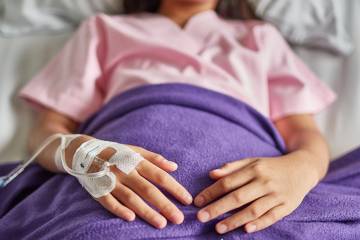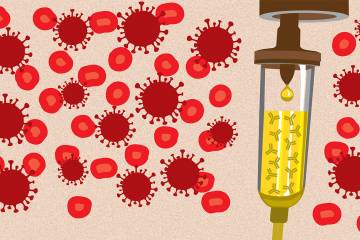As the United States approaches the six-month mark of its first confirmed case of the coronavirus, a group of Johns Hopkins experts convened today to discuss the current state of the pandemic, what we've learned so far about the SARS-CoV-2 virus that causes COVID-19, and the obstacles ahead.
Here's a look at the topics the webinar, hosted by Johns Hopkins Medicine, explored:
Convalescent plasma
Johns Hopkins this month began randomized controlled trials for the promising therapy option of convalescent plasma, said Shmuel Shoham, associate professor of medicine at the School of Medicine. "We take people who have survived infection, harvest their antibodies, and give them to people who are at risk or already have the infection who have infection at early stage," he said. Information about trials is available at covidplasmatrial.org.
Shoham said researchers are gathering a wealth of data on "exactly what patients [the treatment] works best in, and exactly what kind of plasma is the best." Refinement of this procedure, he said, will lead to treatments using "hyper-immune globulin," which contains the most effective antibodies for protecting against COVID-19.
Health inequities
The disproportionate impact of the pandemic on African-American, Latino, and Native American communities is "one aspect of the pandemic that unfortunately is not a surprise," said Sherita Hill Golden, vice president and chief diversity officer at Johns Hopkins Medicine.
She noted, for example, that African-Americans account for about 21% of the coronavirus death rates in the U.S., yet represent just 13% of the population. While higher rates of underlying health conditions—diabetes, hypertension, cardiovascular disease, or lung disease, for example—can partially explain the greater death rate, Golden pointed out that decades of structural racism and healthcare inequality have contributed to creating disproportionate rates of those preexisting conditions in communities of color in the first place. She also said people of color can be more at risk to COVID-19 due to conditions like crowded housing, higher incarceration rates, and employment in essential roles such as transportation and food service.
Addressing the George Floyd protests, Golden said: "If we think about what's at the root of the protests about police brutality, and then we look at the COVID disparities, they really have the same root in the structural racism and the discrimination, and that's really what everyone is trying to address. But we've got to do this in a socially distant, appropriate way, using public health measures."
How the virus affects children
Contrary to initial beliefs that coronavirus mostly spared children, hundreds of cases have now been reported of multisystem inflammatory syndrome among young patients, a condition where different body parts can become inflamed. "This is a really serious complication of this pandemic for children," said Aaron Milstone, professor of pediatrics at the JHU School of Medicine. "Fortunately this remains rare, but it is concerning."
What will reopening society mean for kids and their activities? Things almost certainly won't return to the way they were before, Milstone said. "People need to start to accept that things will look different for the next six to 12 months," he said. "Camps will look different, schools will look different—classroom sizes may be smaller, the days may be scheduled differently, there may be hybrid models of learning. We're encouraging people to be patient and amenable to changes that will not only allow kids to be kids and have fun and play learn but will also keep them safe."
Contact tracing
With new hot spots of the coronavirus emerging in different parts of the country, contact tracing—reaching individuals who have may been exposed to the virus and advising quarantine—is the most effective tool we have right now to break chains of transmission, said Crystal Watson, senior scholar at the Johns Hopkins Center for Health Security. She said the U.S. has made progress in building up its contact tracing workforce, but still falls far short of the estimated 100,000 needed.
Contact tracing is essential, Watson said, for following cases spreading from high-density, high-risk sites like correctional facilities, long-term care centers, and meat-packing plants. "We need to work hard to get better control of the virus in these settings, because I think they are driving a lot of the transmission that we're seeing," she said.
The current landscape, and challenges ahead
Confirmed cases of the coronavirus in the U.S.—which total more than 2.1 million—are distributed unevenly around the country, with more than half of states now experiencing increases, said Lisa Maragakis, senior director of infection prevention in the Johns Hopkins Health System. "There is concern that we've seen a plateauing in our country," she said, noting that "we really still are in our first wave of the pandemic," with experts expecting a second surge arriving in fall with flu season.
Maragakis emphasized that there's a significant time lag to see changes in our data following policy and behavioral changes, like state re-openings or widespread protests. "Many of us look in the ensuing week or two to see if we see effects," she said, but "it takes a number of weeks before you see that signal."
While the U.S. has improved testing capacity, Maragakis said she remains concerned about challenges involving access to testing and uneven supply chains for items like hand sanitizer, personal protective equipment, and reagents for performing tests. She added that she is also concerned about the way the virus affects multiple organs—it's not just a respiratory virus, and must be addressed holistically, taxing health care providers.
Finally, she outlined the challenges of misinformation and a lack of leadership during the pandemic: "[There is no] cohesive, consistent public health message about what we need to do to get through this enormous challenge and crisis."
Posted in Health, Voices+Opinion
Tagged public health, johns hopkins medicine, coronavirus, covid-19












